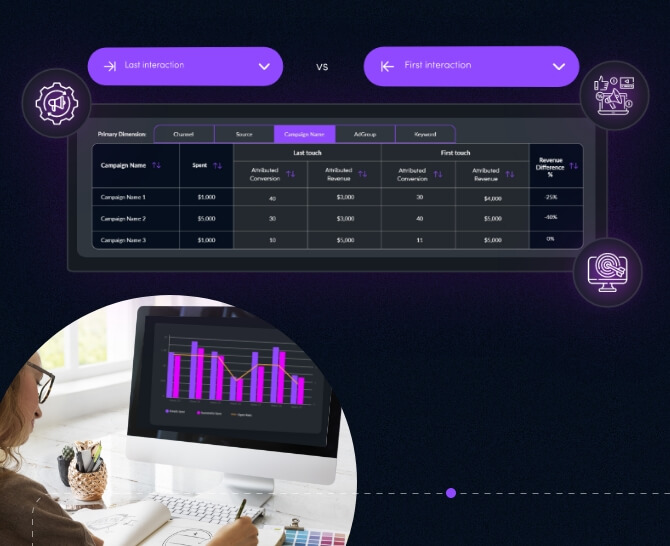
Single-Touch Versus Multi-Touch Attribution: Which Is Right for You?
With multiple channels and platforms, there are many touchpoints that your customers interact with. In order to make sense of your marketing effort, which attribution model should businesses use?
In today’s competitive marketing environment, businesses have more than one way to reach their potential customers. However, the increasing number of channels complicates matters when figuring out their role and value in your marketing efforts. For instance, if a user visited your Facebook page in the past but shopped through an email link, which marketing channel do you give credit for the sale?
As a marketer, you’d face similar questions when you use multiple channels to reach prospective customers. Inability to determine the role of different channels might lead to wasting precious marketing resources or putting your marketing budget on the wrong horse. If you are wondering how to judge the effectiveness of your marketing campaign, Marketing Attribution has all your answers.
We discussed the importance of investing in Marketing Attribution in an earlier post. Modern marketers need attribution to dig deeper into their marketing efforts. It is used to determine the marketing effectiveness and role of marketing touchpoints that lead to a conversion. Using marketing attribution tool, you can quickly identify what works and what doesn’t and improve the personalization of your campaign.
However, choosing a suitable attribution model isn’t easy. Most marketers are in a dilemma when choosing between single-touch and multi-touch attribution models. In this write-up, we shall look at both these models closely and help you choose the right one based on your business needs.
Single-Touch Attribution
It assigns 100% of the credit to a marketing touchpoint. Single-touch models are easy to implement and best used for businesses that have an uncomplicated business model. Let us look at the types of single-touch attribution models.
- First-Touch
- Last -Touch
- Last Touch Non-Direct
The first-touch model assigns 100% credit to the first touchpoint or the awareness stage in the customer’s buying journey. However, this model ignores the role of all other touchpoints in the buying journey.
The exact opposite of the first-touch model assigns 100% credit to the last touchpoint. It is uncomplicated but ignores the impact of all other touchpoints leading up to the last one.
It is slightly different from the last-touch model as it assigns 100% of the credit to the last non-direct touchpoint. For example, if a user buys a subscription from the store, the model steps back and assigns credit to the touchpoint before the user visits the store.
Multi-Touch Attribution
As the name suggests, the multi-touch attribution model looks beyond the buying journey’s first and last touch. It weighs the importance of other touchpoints and assigns credit based on their impact.
Here are the most widely used multi-touch models.
- Linear Attribution
- U-Shaped Attribution
- W-Shaped Attribution
- Time Decay Attribution
- Custom Attribution
The linear model divides the credit equally between all the touchpoints in the buyer’s journey. It is the easiest multi-touch attribution model to implement. It is a widely used model as it considers all the touchpoints the buyer has used till the final conversion. However, this model doesn’t provide insights into the impact of different touchpoints on the buyer’s journey.
This attribution model considers the first and the last touchpoints as the most important ones in the buyer’s journey. It assigns 40% credit each to these touchpoints and the remaining to other touchpoints. It best serves the interests of businesses with short sales cycles where awareness and lead conversion stages are the most important.
This model shares 30% of the credit each to the first, last, and opportunity creation touchpoints. The remaining touchpoints get 10% credit. It is the only model that stresses the importance of touchpoints in the middle stages of a customer’s journey.
The time decay attribution model offers more credit to the touchpoints closer to the conversion. It helps track the impact of the marketing campaign on leads at the bottom of the funnel. However, this model works best when there are fewer touchpoints at the top of the funnel.
All single-touch and multi-touch attribution models have cons, and none of the above models may offer you the insights you need. In such an event, you can choose custom attribution models. These mix two or more attribution models combining their best features.
What to Choose? Single-Touch vs. Multi-Touch Attribution
We have come to the most important question – whether you should opt for a single-touch or multi-touch attribution model. There are no easy answers, as both have their pros and cons. The ideal path is to choose a model that lets you measure your campaign’s impact and map your buyer’s journey. Here are a few pointers for choosing a suitable attribution model for your business.
- Short Sales Cycle
- Long Sales Cycle with Lead Gen
- Recurring Revenue Business
A single-touch attribution model will fit the bill perfectly if you have a short and uncomplicated sales cycle. It applies to businesses that target distinct customer groups on different channels. For example, if you run an online store, you can use the first-touch or last-touch model to track engagement with the customer. Some online stores also prefer the U-Shaped model as it helps monitor the two most essential touchpoints in the buying journey – awareness and lead conversion.
If a long sales cycle extends into months, multi-touch models can offer deeper insights into a customer’s mind. The Time Decay model is preferred by most businesses in the B2B industry as it tracks channels and campaigns that transform intent into a conversion.
In the case of recurring revenue businesses, the linear attribution model is a good fit. With this, you can keep track of ongoing customer engagement as it treats all engagements with the customers equally.
Understanding Single Touch Technology
Single touch technology refers to a type of input method that allows users to interact with a device or interface by touching it with a single finger or stylus. This input method is commonly found in a variety of electronic devices, including smartphones, tablets, and handheld gaming devices.
One of the main components of single touch technology is the touch sensor. The touch sensor detects the position and movement of the user’s finger or stylus on the surface of the device. It then translates this input into a specific action or command, such as scrolling, tapping, or swiping.
Examples of single touch input devices include resistive touchscreens, which rely on pressure-sensitive layers to detect touch, and capacitive touchscreens, which use electrical conductivity to register touch input. These devices are commonly used in a wide range of applications, such as navigation systems, point-of-sale terminals, and interactive kiosks.
While single touch technology offers a simple and intuitive way for users to interact with devices, it does have its limitations and constraints. One of the main limitations is the inability to track multiple touch points simultaneously. This means that single touch devices are unable to support gestures such as pinch-to-zoom or rotate.
In addition, single touch technology may also be less responsive than multi-touch technology. This can result in a slight delay between the user’s touch input and the device’s response, which can impact the overall user experience.
Key Points:
- Single touch technology allows users to interact with devices using a single finger or stylus.
- Examples of single touch devices include resistive and capacitive touchscreens.
- Single touch technology has limitations in terms of multi-touch support and responsiveness.
Exploring Multi-Touch Technology
Multi-touch technology refers to the capability of a device to detect and interpret multiple simultaneous touch points on its screen. Unlike single touch technology, which can only recognize one touch point at a time, multi-touch technology allows for a more intuitive and interactive user experience.
There are various examples of multi-touch input devices that utilize this technology. One of the most common examples is the smartphone, which enables users to perform various gestures such as pinch-to-zoom, swipe, and rotate using multiple fingers. Multi-touch technology has also revolutionized the way we interact with tablets and touch screen laptops, providing a more natural and fluid touch experience.
Multi-touch technology offers several advantages over single touch technology, especially when it comes to user interaction possibilities. With multi-touch, users can perform complex gestures and manipulate objects on the screen more easily. This enhanced interaction capability opens up new opportunities for applications such as gaming, graphic design, and virtual reality.
The benefits of multi-touch technology extend beyond entertainment and creativity. In healthcare, for example, multi-touch screens enable surgeons to navigate through medical images and data with precision and ease. In education, multi-touch displays enhance the learning experience by promoting active participation and collaboration among students.
Furthermore, multi-touch technology has had a significant impact on various industries, including retail, hospitality, and automotive. In retail, multi-touch displays are used to create interactive product catalogs and digital signage, enhancing the customer shopping experience. In the hospitality industry, touch screen kiosks enable guests to easily access information and services, improving efficiency and customer satisfaction. Automotive companies have also embraced multi-touch technology by incorporating it into car infotainment systems and driver interfaces, enhancing the driving experience.
When choosing the right touch technology for your product, it’s crucial to consider the specific requirements and use cases. While single touch may be sufficient for certain applications, multi-touch technology offers a more advanced and interactive experience for products that require complex user interaction.
Key Differences between Single Touch and Multi-Touch
Single Touch and Multi-Touch technologies may appear similar, but there are significant differences between the two. Understanding these disparities can help you make informed decisions about which technology to implement. Below are the key differences between Single Touch and Multi-Touch:
- Comparison of the number of touch points supported by each technology.
- Examination of how gesture recognition differs for single touch and multi-touch devices.
- Evaluation of the usability and responsiveness of single touch vs multi touch.
Single Touch technology allows only one touch point at a time, while Multi-Touch technology enables the detection of multiple touch points simultaneously. This fundamental distinction directly affects the functionality and usability of devices that utilize these technologies.
Single Touch devices typically support basic gesture recognition such as tapping and swiping, while Multi-Touch devices offer advanced gesture recognition capabilities like pinching, rotating, and zooming. Multi-Touch technology provides a more intuitive and immersive user experience due to its ability to interpret complex gestures accurately.
While Single Touch technology is simple and easy to use, Multi-Touch technology significantly enhances the usability and responsiveness of devices. Multi-Touch devices respond swiftly to user input, making them more efficient and enjoyable to interact with. On the other hand, Single Touch devices may have noticeable delays and limitations in responsiveness.
In conclusion, Single Touch and Multi-Touch technologies exhibit crucial differences in terms of touch point support, gesture recognition, usability, and responsiveness. When choosing between these technologies, consider the specific requirements of your product and the desired user experience.
Impact on Business and Marketing
Touchscreen technology has revolutionized customer touchpoints and transformed the way businesses interact with their target audience. With the advent of single touch and multi-touch technologies, businesses have the opportunity to elevate their marketing analytics strategies and enhance customer experiences.
- Touchscreen Technology and Customer Touchpoints
- The Role of Single Touch and Multi-Touch Technologies in Marketing Strategies
- Leveraging Single Touch and Multi-Touch Technologies for Improved Customer Experiences
The introduction of touchscreen technology has expanded customer touchpoints beyond traditional methods. With single touch and multi-touch, businesses can engage customers on multiple marketing platforms, including smartphones, tablets, and interactive kiosks. These technologies enable businesses to create seamless and personalized experiences, improving customer satisfaction and customer retention.
Single touch and multi-touch technologies play a crucial role in modern marketing strategies. Single touch technology allows businesses to focus on individual interactions, providing targeted and specific messaging to customers. On the other hand, multi-touch technology enables businesses to create holistic and integrated marketing campaigns, spanning across various touchpoints.
By analyzing user behavior and engagement, businesses can optimize their marketing strategies using single touch and multi-touch technologies. Single touch helps identify specific touchpoints that drive conversions, while multi-touch provides a comprehensive view of the customer journey, allowing businesses to understand the impact of each touchpoint on customer decision-making.
Businesses can leverage single touch and multi-touch technologies to improve customer experiences. With single touch, businesses can create personalized dashboard and targeted messaging that resonates with individual customers. This not only increases engagement but also fosters stronger customer relationships.
Multi-touch technologies allow businesses to deliver consistent and interconnected messaging across various touchpoints. By combining multiple touchpoints, businesses can provide a seamless and cohesive customer journey. This enhances brand perception and ensures a unified customer experience.
Choosing the Right Touch Technology for Your Product
When it comes to implementing touch technology in your product, there are several factors to consider in order to make the right choice between single touch and multi-touch technologies. Here are some important considerations:
- Evaluation of the target audience and their preferences
- Cost analysis and considerations
- Recommendations and best practices
Understanding your target audience is crucial in determining the type of touch technology that will best suit their needs and preferences. Consider factors such as their technical proficiency, usage patterns, and expectations. For instance, if your target audience is tech-savvy and accustomed to using touchscreens, multi-touch technology might be the preferred choice.
Implementing touch technology can involve significant costs, so it is essential to conduct a thorough cost analysis. Compare the costs of single touch and multi-touch technologies, taking into account factors such as hardware, software, maintenance, and potential upgrades. Additionally, consider the long-term benefits and ROI of each option.
Every business scenario is unique, so it is important to carefully evaluate your specific needs and requirements. Seek recommendations and best practices from industry experts and professionals who have experience with similar projects. They can provide valuable insights and guidance on selecting the most appropriate touch technology for your product.
Remember, the right touch technology can greatly enhance the user experience of your product, improve customer satisfaction, and contribute to the overall success of your business.
Wrapping Up
In summary, marketing attribution is powerful for tracking engagement and for judicious use of your marketing resources. Choose a model based on your needs that helps accurately map your marketing campaign’s impact. Be open to custom attribution models where you combine single-touch and multi-touch models.
Let DiGGrowth Handle Marketing Attribution For You
While you focus on creating the best marketing campaigns for your organization, let DiGGrowth—a No-code Marketing Intelligence Platform—help you with marketing attribution. DiGGrowth uses machine learning to accurately understand how each marketing touchpoint contributed to a conversion, thereby helping you make fearless marketing decisions.
Ready to get started?
Increase your marketing ROI by 30% with custom dashboards & reports that present a clear picture of marketing effectiveness
Start free trail
Experience Premium Marketing Analytics At Budget-Friendly Pricing.

Learn how you can accurately measure return on marketing investment.
Additional Resources
15 Rules of Sales Analytics for Cleaning the Pipeline: Unearth Gold, Leave Behind Fool’s Gold Outline
As a sales manager, you already know that...
Read full post postThe OpenAI Shake-Up: Navigating Success with DiGGrowth’s Hybrid Approach
Artificial intelligence is undoubtedly a game-changer for businesses...
Read full post postEnhancing Lead Nurturing with Revenue Attribution Turning Leads into Sales
In a digital-first world, the competition has touched...
Read full post postFrequently Asked Questions
Marketing attribution is a method used by marketers to determine the effectiveness and role of various marketing touchpoints in leading to a conversion. It helps analyze and measure the impact of different channels and campaigns in order to optimize marketing efforts.
The types of single-touch attribution models are:
First-Touch: Assigns 100% credit to the first touchpoint in the customer's buying journey.
Last-Touch: Assigns 100% credit to the last touchpoint before conversion.
Last Touch Non-Direct: Assigns 100% credit to the last non-direct touchpoint before conversion.
The most widely used multi-touch attribution models are:
Linear Attribution: Divides credit equally among all touchpoints in the buyer's journey.
U-Shaped Attribution: Assigns 40% credit each to the first and last touchpoints, with the remaining credit to other touchpoints.
W-Shaped Attribution: Allocates 30% credit each to the first, last, and opportunity creation touchpoints, with 10% credit to remaining touchpoints.
Time Decay Attribution: Gives more credit to touchpoints closer to the conversion, focusing on the impact of the marketing campaign on leads at the bottom of the funnel.
Custom Attribution: Combines two or more attribution models to create a customized approach based on specific needs.
A business should consider using a single-touch attribution model if it has a short and uncomplicated sales cycle, targets distinct customer groups on different channels, or wants to focus on specific touchpoints in the buying journey.
A business should consider using a multi-touch attribution model if it has a longer sales cycle, particularly in industries like B2B, where deeper insights into the customer's journey are necessary. Multi-touch models are also suitable for recurring revenue businesses and when tracking ongoing customer engagement is important.
 Subhadeep Bhattacharjee
Subhadeep Bhattacharjee 

